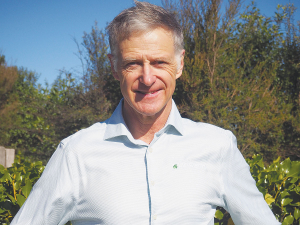Spelling pastures
To build resident populations of subterranean clover in hill country pastures, sheep farmers are encouraged to spell selected areas for four to five weeks over late spring and early summer if possible.
 Andrew Johnston from Luisetti Seeds says Puawhaa is the only sub clover selected in NZ specifically for NZ hill country environments.
Andrew Johnston from Luisetti Seeds says Puawhaa is the only sub clover selected in NZ specifically for NZ hill country environments.
A subterranean clover adapted for East Coast hill country farming systems is being made available to farmers after decades of sitting on the shelf.
Canterbury-based seed company Luisetti Seeds is launching Puawhaa subterranean (sub) clover onto the market this spring - ready for sowing next autumn.
Puawhaa is an ecotype of the subterannean (sub) clovers (Mt Barker and Tallarook) oversown on North Island hill country in the 1940s and 50s.
Luisetti Seeds’ Andrew Johnston says in the late 1980s, scientists working at Whatawhata Research Centre, near Hamilton, selected a line of sub clover suitable for low fertility, intensively grazed, dry hill country.
“It was more prostrate, dense and later flowering than the Australian sub clovers,” he explains.
“More importantly, it was adapted to New Zealand farming conditions.”
In the late 1990s, the clover (given the title WS1801) went through all the testing regimes and registrations required to commercialise it. However, the clover never made it to market – until now.
Johnston says Luisetti Seeds was searching for a clover with a prostrate crown, runners and a later season flowering date as these characteristics all promote re-seeding.
He says WS1801 ticked all the boxes in term of drymatter production as well as being an exceptional re-seeder. It has the ability to produce more than 200 plants per square metre and yield over 1,000 kg/DM/ha in spring.
“It is particularly exciting that this is the only sub clover selected in NZ specifically for NZ hill country environments.”
In looking for a name for the clover, Johnston consulted with Ngaati Maahanga whose land includes the former Whatawhata Research Station, now Te Rauputiputi. In recognition of the work and research carried out on WS1801, the iwi gifted the name Puawhaa, meaning flower of the plant with four leaves.
Johnson says, as a medium to later maturing cultivar, Puawhaa will complement early flowering varieties of sub clover and sown in combination. He claims that Puawhaa will ensure a longer supply of feed during the spring production period.
“With the correct management, sub clover, which thrives in welldrained, sunny, low rainfall areas, has proved transformative on many east country hill country farms throughout New Zealand, giving farmers the ability to drive high pre-weaning growth rates,” Johnson explains.
“This allows farmers to maximise their weaning draft and partition feed back into ewes to build body condition going into the following autumn’s mating.”
Former Agriculture Minister and Otaki farmer Nathan Guy has been appointed New Zealand’s Special Agricultural Trade Envoy (SATE).
Alliance Group has commissioned a new heat pump system at its Mataura processing plant in Southland.
Fonterra has slashed another 50c off its milk price forecast as global milk flows shows no sign of easing.
Meat processors are hopeful that the additional 15% tariff on lamb exports to the US will also come off.
Fears of a serious early drought in Hawke’s Bay have been allayed – for the moment at least.
There was much theatre in the Beehive before the Government's new Resource Management Act (RMA) reform bills were introduced into Parliament last week.

OPINION: The release of the Natural Environment Bill and Planning Bill to replace the Resource Management Act is a red-letter day…
OPINION: Federated Farmers has launched a new campaign, swapping ‘The Twelve Days of Christmas’ for ‘The Twelve Pests of Christmas’ to…